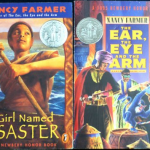
A Girl Named Disaster


Title: A Girl Named Disaster
Author: Nancy Farmer
Primary Audience/age group: 14+
Genre: Adventure/Coming of Age story/Multicultural
# Of pages: 293
Publisher: Orchard Books
Year of Release: 1996
Part of a Series? No
Rating: 3 (View Scale)
Recommend: Yes, with reservation
Description: (from book jacket) Her grandmother said, The journey will be the hardest thing youll ever do, but it will be worth it. Just think of finding your father. And so Nhamo, fleeing an impending marriage to a cruel man with three wives, sets out for Zimbabwe, alone on the Musengezi River. She is not yet twelve. Soon, strong currents sweep her canoe to the uncharted heart of Lake Cabora Bassa in Mozambique. As she struggles to escape drowning and starvation, she comes close to the luminous world of the African spirits. Loneliness drives her to join a baboon troop on an island, with near-deadly results. But Nhamo is bold and resourceful and discovers in conversations with her dead mother and the Ancestors how to survive the terrors that seem to rise around her from all sides. Yet the greatest terror is still to come after she again reaches civilization. Nhamos journey of spirit as well as body will keep readers enthralled to the very last page.
Review: Well, it didnt keep me enthralled to the very last page, but I have to admit, I felt compelled to continue reading this book until the end. Ive never been a big fan of the girl facing the dangers of nature alone with animal friends genre (as in Julie of the Wolves or Island of the Blue Dolphins, which this book resembles). Several times I found myself feeling somewhat impatient when the narrative came to a stop so Nhamo could tell a story about the African spirits, and sometimes I wanted to shake her and say, Quit letting yourself starve! Have some common sense and get off that island! However, Nhamo is a sympathetic enough character that I wanted to see how her story ended.
Rating: 3 for more intense sequences of violence
Recommend: Yes, with reservation
Positive: Nhamo is resourceful and self-reliant. She works hard and manages to survive a journey one would think would be impossible for a young girl. The book also is a good example of multicultural literature, describing life in a primitive African village and set against the background of the civil wars in the history of southern Africa.
Spiritual Elements: Spiritual elements are at the heart of this book. It is because of a ngozi (angry, revengeful spirit) who is revealed by a muvuki (what we would call a witch doctor) that she has to leave her home. During her journey, Nhamo converses on a regular basis with the spirits of her dead mother and a dead villager whose boat she has taken to escape the village. She also gets advice from the njuzu, the water spirits, and makes sure she makes appropriate sacrifices to thank them and the Ancestors. One of the most disturbing parts of the book is when she encounters the spirit of a witch, who later possesses her and has to be exorcised by the Vapostori (a sect of Christians that was formed in Africa in 1932). The book also gives Nhamos reactions to Christianity, which may disturb some readers, since she interprets it through the lens of her spirit religion.
Violence: Although the violence isnt glorified, there is quite a bit of it inherent in the story. Its taken for granted that people have the right to beat other people who displease them. Nhamo has to kill animals to provide food for herself, and the grossest scene of violence comes with her first experience of hunting. The most disturbing scenes of violence, though, come when Nhamo is possessed by the witch and kills a dog that is chasing her away from white peoples houses, and then again later when she attacks another dog who reminds her of the first one.
Language: It seems that I remember a few offensive words, but a very few. The most offensive thing I remember is the witchs name (Long Teats).
Sexual Content: The sexual content of the book is centered around menstruation as a sign of womanhood. The story describes the rituals that Nhamos family undertakes when her cousin has her first period and becomes a marriageable young woman. Later, when Nhamo is on her journey, she reaches the same milestone. Its not a major theme in the book, but it is mentioned now and then. At the end of the book, Nhamo finds out her mother was already pregnant when she married Nhamos father.
Other: There is a LOT of information about southern Africa in this book, ranging from the native religion, to the types of plants and animals, to the weather patterns, to the interaction between natives and whites. Although I got annoyed that Nhamo would go into storytelling mode and pause the narrative, her stories were interesting. Given that I knew next to nothing about Africa before reading the book, I think it has value as a teaching tool by managing to work all these elements into a book that reads like a story instead of a textbook. There are also sections at the end of the book that provide a glossary of the African words used in the story and an overview of the spirit religion.
Recommendation: I would suggest this book for more mature teens. I think younger kids would be turned off by the frequent use of African words and embarrassed by the frank way the book talks about menstruation. The focus on the spirit world and its differences to Christianity might be something parents and teens could discuss, as well.
Comments are Closed